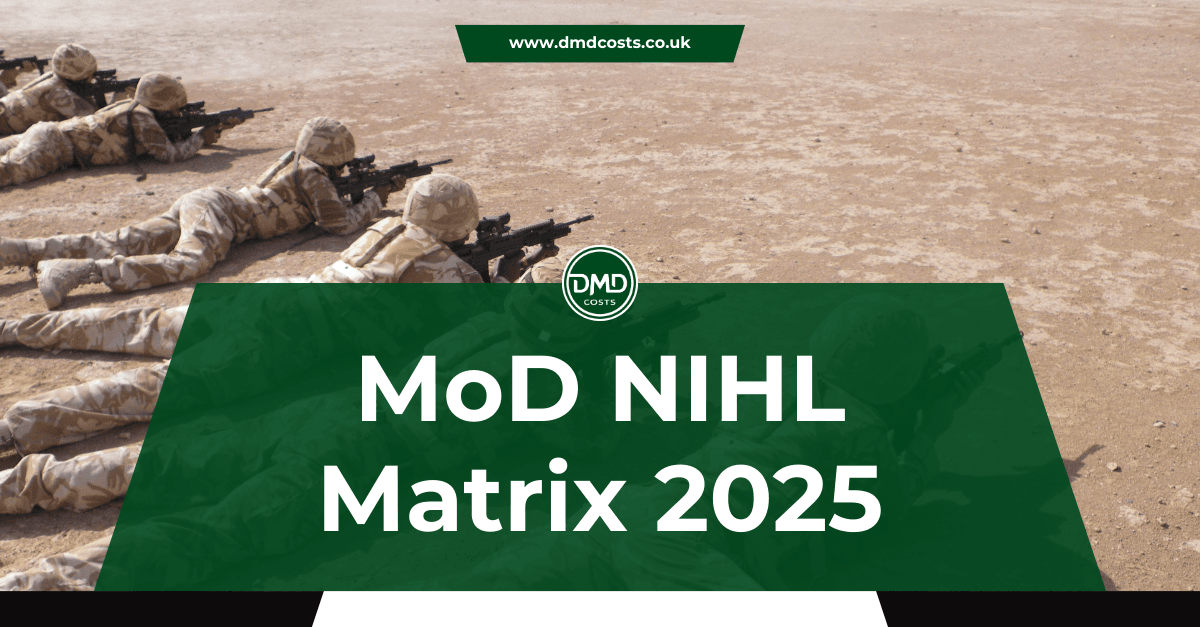

Updated November 2025.
The MoD NIHL “matrix” standardises damages only. Inter-partes costs remain CPR-governed on the standard basis (or indemnity where engaged). Below is the playbook: split-settlement wording, Part 36 timing, disclosure arguments and a billing checklist you can paste into your next file.
________________________________________
• Free trial: We draft & negotiate one Bill of Costs to settlement at no charge.
• After that: £500 all-in per file (drafting + negotiations + settlement paperwork).
• SLA: 5 working days. Costs Lawyer-led. UK-wide, paperless.
CTA: Send your first MOD NIHL file → info@dmdcosts.co.uk | +44 7724 108 587
________________________________________
• What the matrix is: High Court-approved damages settlement framework from the Hugh James litigation (8 Jul 2024). Not statutory; does not displace CPR on costs.
• Costs are not fixed: Annex E (Disease PAP) E4(a) excludes military claims from NIHL FRC → hourly rates apply (standard basis unless indemnity engaged).
• Keep damages and costs separate: A matrix offer usually covers damages only. If costs aren’t agreed, proceed to CPR 47 detailed assessment (N252).
________________________________________
The matrix grew out of group litigation against the MoD and was approved on 8 July 2024. It standardises compensation (e.g., by service dates/tinnitus/audiology) to reduce friction and delay in damages settlement.
Key point: It does not fix inter partes costs—costs remain under the CPR.
Practical point: Expect “matrix-style” figures in other files. Treat them as commercial offers on damages. Negotiate costs separately.
________________________________________
Under Annex E, E4(a) of the Disease & Illness PAP, military claims are excluded from NIHL FRC. So FRC tables don’t bite; you’re back in the hourly world (standard basis unless indemnity applies). You’ll typically still need a Bill of Costs, unless costs are expressly agreed.
________________________________________
A matrix figure resolves damages. Unless the document says otherwise, costs follow CPR:
• Record settlement in two limbs: (i) damages per matrix (plus CRU), (ii) costs: to be assessed if not agreed.
• If costs stall, commence detailed assessment: serve N252 + Bill under CPR 47.6.
________________________________________
• Default on MoD NIHL (FRC excluded): draw a PD 47-compliant (e-)Bill, phased.
• Indemnity windows: if you beat your own Part 36 or prove misconduct, seek indemnity costs for that period. Remember CPR 3.18 budget limits bind only the standard basis, not indemnity.
________________________________________
• Matrix paperwork: keep the offer/approval note + eligibility (service dates, audiology).
• Time records by phase: NIHL disclosure can be heavy—log volume and complexity.
• Disbursements: audiology/ENT, military records, tracing/defunct-entity steps, counsel—keep vouchers + short necessity narratives.
________________________________________
NIHL claims against the MoD continue at scale. The matrix accelerates damages; costs remain CPR-driven. Set expectations: faster damages, separate costs negotiation/assessment.
________________________________________
1. Read the offer carefully: if silent on costs, they’re to be assessed per CPR.
2. Part 36 early: once eligibility/liability are clear, serve a realistic claimant Part 36. If beaten at judgment, CPR 36.17 triggers indemnity, interest uplifts, and the additional amount (10%/5% to £75k).
3. Consent/Order wording: split damages (matrix + CRU) from costs (assessed/paid under CPR).
4. Bill & N252 early: keep pressure on; chase Default Costs Certificate if PoDs don’t arrive in 21 days.
5. Indemnity periods: where engaged, budget caps (CPR 3.18) do not limit indemnity assessment.
________________________________________
• Bills & e-Bills that map NIHL phases and evidence burden (PD 47-compliant).
• Part 36 strategy & protective wording so you don’t concede costs.
• Negotiation & hearings: PoDs, Replies, Default Certificates, assessments—we press on until every penny is paid.
• Military-claim know-how: arguments aligned to Annex E exclusions and NIHL disclosure realities.
________________________________________
Use in letters/consent orders:
“Damages: agreed per matrix (plus CRU). Costs: to be paid on the standard basis, to be assessed if not agreed, with a payment on account under CPR 44.2(8) within 14 days.”
N252 served; DCC diary for day 22 if PoDs late.
No. It’s a damages framework; costs remain under the CPR.
No. Annex E, E4(a) excludes military claims from NIHL FRC.
Yes—unless costs are expressly agreed. Otherwise serve N252 and proceed under CPR 47.6.
Yes—e.g., if you beat your own Part 36 at judgment (36.17 consequences).
Matrix terms/letters, service & audiology evidence, disclosure indices, time sheets, and all disbursement vouchers.
They can propose them; you’re not obliged. Separate damages vs costs unless the global matches a reasoned Bill.
Two limbs: (i) damages per matrix (plus CRU), (ii) costs per CPR (assessed/paid or as agreed).
Early, once liability/eligibility are clear—so you can leverage 36.17 at judgment.